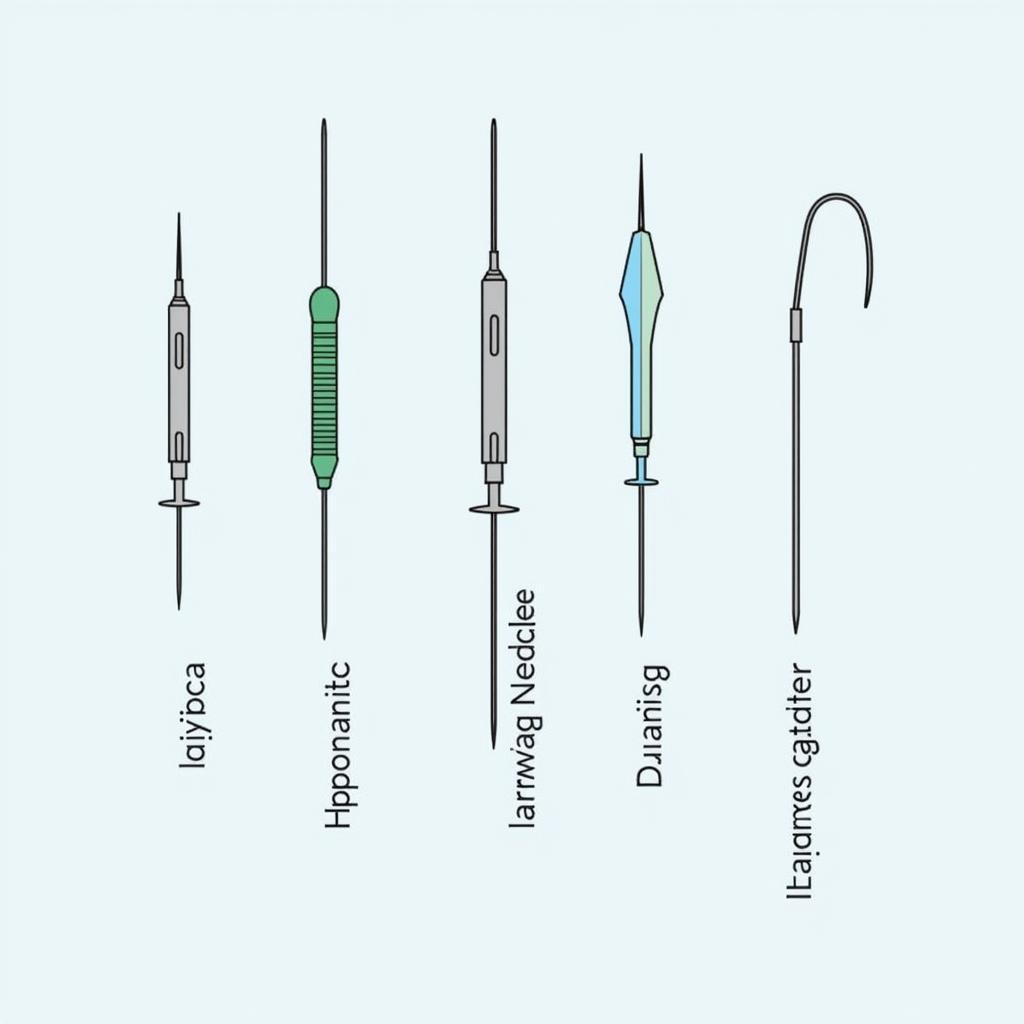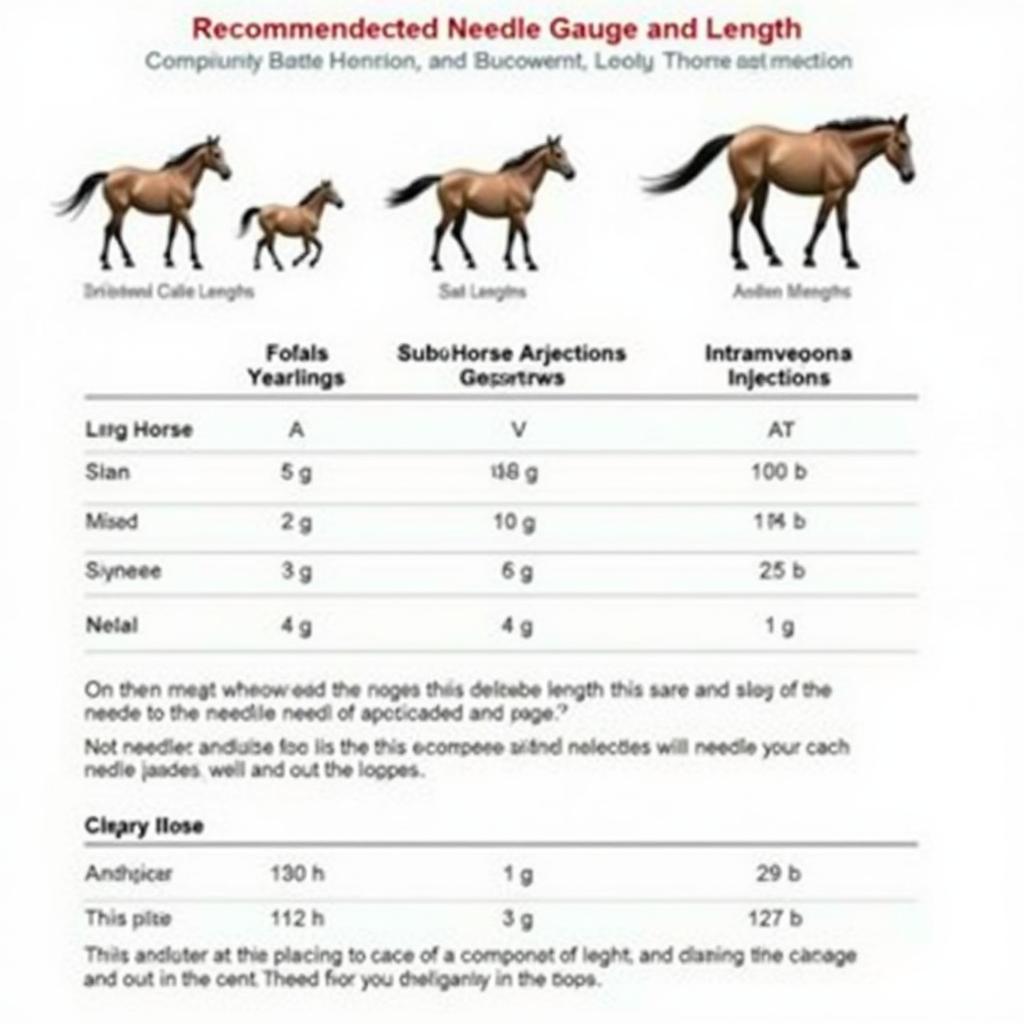Horse Needles. Whether you’re a seasoned equestrian or a new horse owner, these two words likely evoke a range of thoughts, from routine vaccinations to more complex veterinary procedures. This comprehensive guide will delve into the various aspects of horse needles, covering everything from types and sizes to proper usage and safety precautions.
Different Types of Horse Needles and Their Uses
 Types of Horse Needles for Various Veterinary Procedures
Types of Horse Needles for Various Veterinary Procedures
Just like human medicine, veterinary practices utilize a variety of needles designed for specific purposes. Hypodermic needles are the most common type, used for administering medications like vaccines and antibiotics. These needles come in various gauges (thickness) and lengths, chosen based on the viscosity of the medication and the size of the horse. Drawing needles, with their larger bore, are specifically designed for collecting blood samples. Intravenous catheters, while not technically needles, are essential for administering fluids and medications directly into a horse’s bloodstream. Understanding the differences between these types of horse needles is crucial for safe and effective administration.
Choosing the Right Horse Needle Gauge and Length
Selecting the correct gauge and length is vital for both the horse’s comfort and the success of the procedure. A needle that is too small can cause unnecessary pain and tissue damage, while a needle that is too large can increase the risk of infection. Generally, for intramuscular injections in adult horses, a 18-20 gauge needle with a 1-1.5 inch length is appropriate. For smaller horses or foals, a smaller gauge and shorter length needle may be necessary. Always consult with a veterinarian to determine the appropriate needle size for your horse’s specific needs and the medication being administered.
What factors influence needle gauge and length selection?
Several factors influence needle gauge and length selection. The viscosity of the medication being administered is a key factor. Thicker medications require a larger gauge needle to flow smoothly. The size and age of the horse also play a role. Smaller horses and foals require smaller needles. Finally, the route of administration (intramuscular, subcutaneous, intravenous) dictates the appropriate needle length.
 Horse Needle Gauge and Length Chart for Various Injections
Horse Needle Gauge and Length Chart for Various Injections
Safe Horse Needle Handling Practices
Safe needle handling is paramount to prevent injuries to both the horse and the handler. Always approach the horse calmly and confidently, ensuring it is properly restrained. Use a quick, smooth motion to insert the needle, minimizing discomfort. After administering the injection, immediately dispose of the needle in a designated sharps container. Never recap used needles, as this significantly increases the risk of needlestick injuries.
How can I prevent needlestick injuries?
Preventing needlestick injuries involves a combination of proper technique and safety precautions. Always use a new, sterile needle for each injection. Never attempt to recap used needles. Dispose of used needles immediately in a puncture-proof sharps container. Ensure the horse is properly restrained before administering any injections. If possible, have an experienced handler assist you during the procedure.
Understanding Horse Reactions to Needles
While some horses tolerate injections well, others may exhibit signs of discomfort or anxiety. Understanding these reactions is important for ensuring the horse’s well-being and minimizing stress. Common reactions include flinching, tail swishing, and muscle tensing. In some cases, a horse may attempt to kick or bite. Proper restraint and a calm, confident approach can help minimize these reactions.
“A calm and confident approach is crucial when administering injections to horses,” says Dr. Emily Carter, DVM. “Horses can sense fear and anxiety, which can exacerbate their reaction to the needle.”
What to Do in Case of Complications
While rare, complications can sometimes occur following injections. These can include swelling, abscess formation, or allergic reactions. If you notice any unusual swelling, heat, or discharge at the injection site, contact your veterinarian immediately. Similarly, if your horse exhibits signs of an allergic reaction, such as hives, difficulty breathing, or facial swelling, seek immediate veterinary attention.
“Promptly addressing any complications following an injection is essential for the horse’s health and recovery,” adds Dr. Carter. “Early intervention can often prevent more serious issues from developing.”
Conclusion
Understanding horse needles, from their various types and uses to safe handling practices, is essential for any horse owner. By following the guidelines outlined in this guide, you can ensure the safety and well-being of your horse while administering necessary medications and treatments. Remember to always consult with your veterinarian for specific advice tailored to your horse’s individual needs. Horse needles are an important tool in equine healthcare, and with proper knowledge and care, they can be used safely and effectively.
horse trailers for sale tucson
FAQ
- What is the most common type of horse needle? Hypodermic needles are the most common type, used for administering medications.
- How do I choose the right needle gauge? The gauge is determined by the viscosity of the medication and the size of the horse.
- What should I do if my horse reacts badly to an injection? Consult your veterinarian for guidance on managing reactions.
- What are the signs of an allergic reaction to an injection? Hives, difficulty breathing, and facial swelling are potential signs of an allergic reaction.
- How should I dispose of used horse needles? Always dispose of used needles in a designated sharps container.
- Why is it important to not recap needles? Recapping needles significantly increases the risk of needlestick injuries.
- Where can I find more information on horse health and care? Contact your veterinarian or explore reputable online resources dedicated to equine health.
Common Scenarios Involving Horse Needles
- Vaccinations: Routine vaccinations require specific needle sizes and injection techniques.
- Administering Medications: Different medications may require different needle gauges based on their viscosity.
- Collecting Blood Samples: Drawing needles are specifically designed for collecting blood samples.
- Intravenous Fluid Therapy: Intravenous catheters are used for administering fluids directly into the bloodstream.
Further Resources
You might also be interested in learning more about equine first aid or common horse ailments. Check out our other articles on Justus Horses USA for valuable information on horse care.
For any assistance, please contact us at Phone Number: 0772127271, Email: [email protected] or visit us at QGM2+WX2, Vị Trung, Vị Thuỷ, Hậu Giang, Việt Nam. We have a 24/7 customer support team.